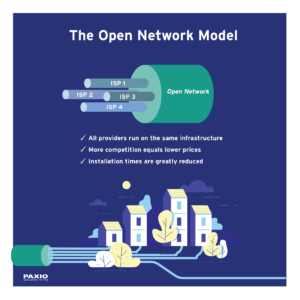- Nov 19, 2019
- Paxio

What is an open network and how do they operate
A fiber broadband network is comprised of the physical fiber-optic infrastructure and the internet service providers. You can think about the physical infrastructure like the pipes that are required to deliver an internet connection into your home and office. The internet service travels down these pipes and is provided by Internet Service Providers.
In an open access model, the infrastructure ownership is separated from the provision of services, so multiple service providers can run within the same infrastructure, and compete on price and service to internet subscribers. In this model, you can think of it as an International Airport. The airport itself provides the infrastructure for individual airlines to offer their own airline services to passengers.
With an open access model, customers are able to experience several benefits that allow them the ability to pick and choose services, from varying providers, according to their needs and budget.
Open Access Network Benefits to Subscribers:
Open Access Networks are gaining more ground in communities globally, as the concept of offering competition between providers, and the freedom of choice for subscribers is essential. Open access can deliver what end users want: choice of providers, choice of services, competitive pricing, and high performance.
Want to learn more about open access networks and fiber internet? Visit OpenFiber today and find out how you can get your neighborhood connected.